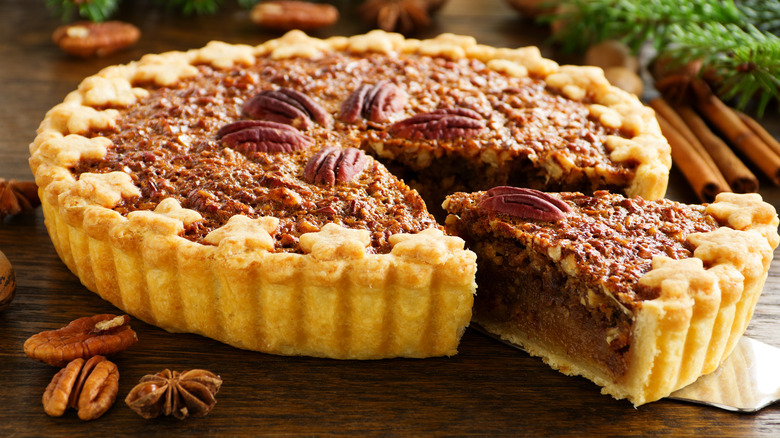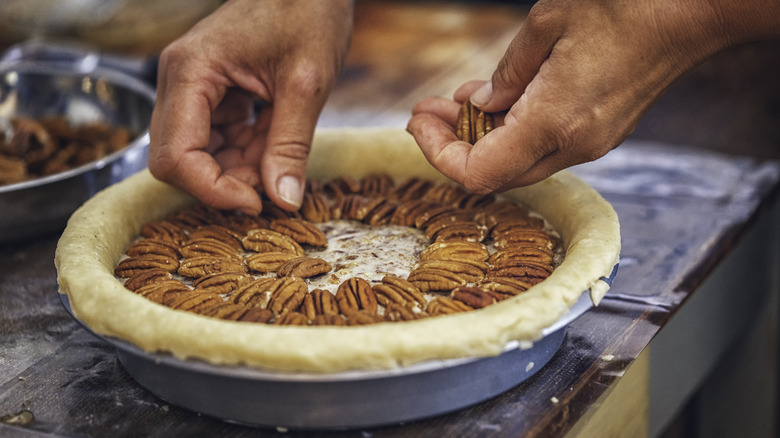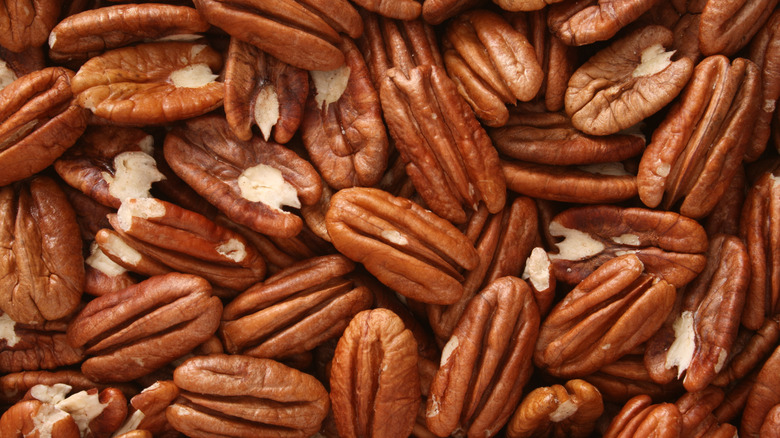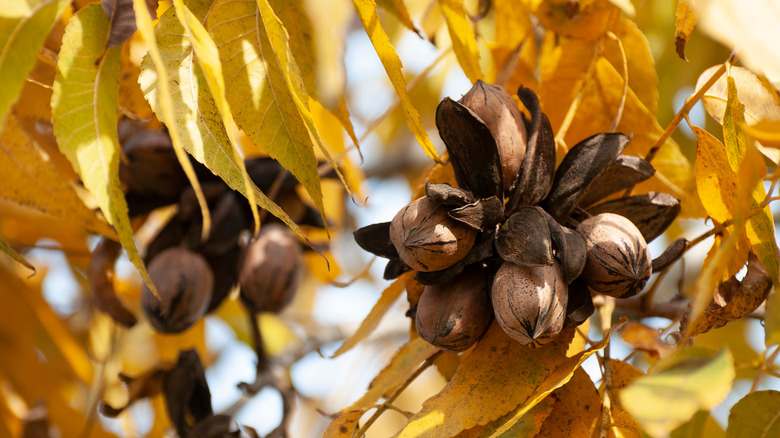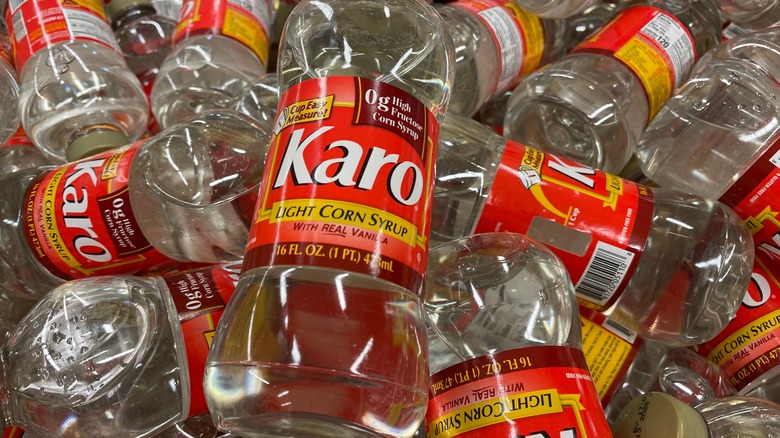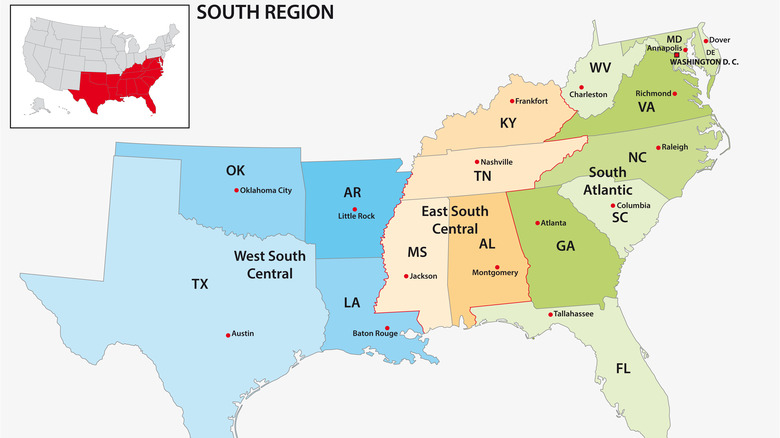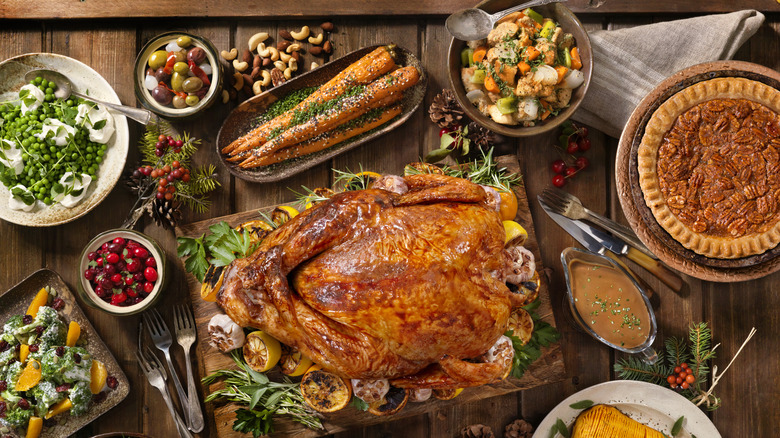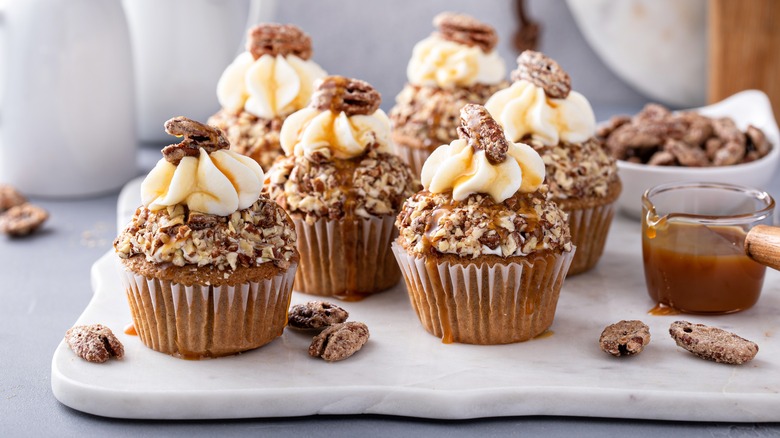How Pecan Pie Became An Iconic Southern Staple
The classic pecan pie is one of few desserts that has remained unchanged after decades. So often, a modernized version of an antiquated dessert comes forward, and the traditional recipe is moved aside. With pecan pie, the original, Southern recipe is widely agreed upon across America, where the dessert reigns not only at Thanksgiving but year-round. Known for its gooey texture and distinct, nutty flavor and crunch, the pie requires only a few ingredients. By combining sugar, softened butter, corn syrup, eggs, vanilla extract, and sometimes maple syrup, you get the sticky, custard-like filling that holds the pecan halves. Fewer ingredients also mean it's a simple pie recipe for beginners.
While pie may not be considered a healthy dish, pecans are particularly nutrient-rich. Not only are they buttery and rich in flavor, but they are an excellent source of fiber, copper, protein, zinc, and healthy fats. Though most can agree that the nut is a good addition to your diet, few can agree on how "pecan" should be pronounced. Regionally, it varies to include such pronunciations as pee-KAHN, pick-AHN, and PEE-can. In the Southern U.S., where the pie is praised, pick-AHN is the preferred pronunciation, although pee-KAHN is primarily used elsewhere. No matter how you pronounce it, this hearty nut is the key to the iconic dessert.
A short history of pecan pie
The origins of pecan pie are overall hazy. Some say it all started when Native Americans gave pecans to French settlers in New Orleans around the 18th century. This may be because the word "pecan" stems from the French word pacane, which is derived from the Algonquian word for nut. Others say it started way earlier, back in Medieval Europe with basic sugar pies and tarts. Though some of the earliest documented recipes for pecan pie were from Texas cookbooks in the 1870s, it is still believed that the dessert originated from an earlier time. Nevertheless, by the time the recipes were written, pecan pie began to take over American kitchens.
Yet back in the day, pies were made as a way to be resourceful. For instance, much like a stew, you could use a few sweet ingredients or several savory ones to make a pie. According to Paula Haney, the founder of the Hoosier Mama Pie Company, "desperation pies" were often basic pies made of little ingredients when most foods were out of season or unavailable. Usually, homemakers would try to elevate simple desserts like vinegar pie, cream pie, and chess pie to taste more like pecan pie.
Pecans aren't necessarily from the South
Pecans are native to North America, but the nut started with indigenous tribes before reaching Louisiana around the 1800s and then Georgia after the Civil War. Originally, pecans were known to Algonquin tribes as pakan (an Algonquin word literally meaning hard-shelled nut), they were prevalent in the central and eastern parts of North America, as well as in Mexican river valleys.
Since the nut naturally thrived in North America, it organically made its way to the South, where it gained a lot of popularity among colonizers. It is said that Thomas Jefferson ventured South and experienced pecans, and upon returning to Virginia, shared the nuts and seedlings with George Washington. Likewise, it has been said that Union soldiers brought pecans back to their families after the Civil War, which helped to spread the nut around the U.S. states. Now, the leading state for pecan production is Georgia, followed closely by Texas, New Mexico, and Oklahoma. Today, California produces the most nuts overall, rivaling these Southern states in their pecan cultivation.
An enslaved Black man helped start commercial pecan production
In 1847 on a plantation in Louisiana, a man named Antoine figured out how to graft pecan trees. This huge accomplishment led to the mass production of the nut. His invention involved joining the scion of one pecan tree with the rootstock of a different pecan tree to make propagation more efficient. Antoine's invention quickly made its way through the Southern states, providing states like Texas and Georgia (which became major hubs for pecan production) with a way to cultivate the nut.
It is because of his invention that the production of pecans rose to extreme highs. By 1867, pecans were sold in New York markets, as well as fairs and festivals. Then by 1897, an early recipe appeared as Texas Pecan Pie. It's wild to think that within 50 years, pecans became one of America's most popular native nuts, and pecan pie became a national treasure all because of the ingenuity of an enslaved man.
Karo syrup changed the pecan pie game
Karo syrup debuted only a few years after Jell-O, joining the wave of easy and convenient packaged foods. In an age where female homemakers were expected to cook nourishing meals every day, these products saved a lot of time and allowed for a lot of creativity. Derived from cornstarch, Karo syrup not only opened the gates for easy pecan pie-making, but helped boost the corn industry that has come to define the Midwest. The company continued making strides with marketing campaigns that consisted of including Karo syrup in several cookbooks from 1910 to 1920, warranting thousands of sales.
While the commercial production of pecans definitely led to the accessibility of pecan pie, the invention of Karo syrup in the 20th century increased its popularity significantly. As both a marketing ploy and a way to employ efficiency, Karo syrup not only was a key ingredient for the pie, but around the 1930s, the syrup bottle also featured a simple pecan pie recipe. Then by the time the 1950s came around, Karo started presenting pecan pie recipes in Better Homes and Gardens. That's really all it took — American homemakers were more than happy to buy up the product and bake pies on the regular. Now that the ingredients were more available than they were in the past, the dessert became a common and exceptionally popular dish, with the historic connection between pecan pie and Karo syrup impossible to ignore.
Now pecan pie is a staple of Southern cuisine
Since much of pecan production came from Southern states and some of the earliest printed recipes for pecan pie were in Texas cookbooks, it makes sense that the dessert was considered to be rooted in the South. Even the first found recipe that truly resembles pecan pie was published in a 1898 cookbook from St. Louis, Missouri — by a Texan woman. With the highest production of pecans being in Southern states like Georgia, Texas, Oklahoma, New Mexico, and Louisiana, it comes as little surprise that pecan pie remained in the region. After the innovation of a Southern slave and the promotional efforts of Karo, pecan pies were soon boasted as the pie of the South by various cookbooks and magazines, and in Texas, it is the state's most iconic dessert.
Moreover, pies in general have long been a tradition of the South. Baking pies goes back to the dismal days of slavery, when enslaved people would sneak dough from their masters after baking pies for them, and then make hand pies for themselves or their families. This is just one of many ways that pies are intrinsically linked with Southern cuisine and history.
Why do we always eat it at Thanksgiving?
First and foremost, pecan harvest season is during the autumn months, from late September into November, so it naturally lines up with the Thanksgiving holiday. But pies at Thanksgiving have been a tradition for many years.
After the Civil War, many Southern leaders often retaliated against Thanksgiving celebrations, thinking it was the North's way to indoctrinate them with Yankee ideals and anti-slavery sentiment. Because of this, pumpkin pies and the holiday were known as Northern customs. One might think it peculiar that pecan pie, and Thanksgiving pie, have become a staple of the South. Perhaps it was Abraham Lincoln who helped set the precedent for the holiday. When he addressed the nation amidst the Civil War with his national Thanksgiving proclamation, he spoke to not just the North or the South, but to everyone. So while some grappled with the political symbolism of the holiday, others came together to celebrate in their own way. The Northern states kept their pumpkin pie, and the Southern states adapted to the holiday with their cuisine: sweet potato pies, and eventually, pecan pies.
How are pecan pies made around the U.S.?
Traditional pecan pies of the South remain essentially the same. Thanks to various cookbooks and Karo syrup, the dessert calls for the same few ingredients. Sometimes, maple syrup is added, but that's just another version of the classic. Yet classics often get a twist, so variations like pecan pie truffles, chocolate pecan pie, coffee pecan pie, coconut pecan pie, and pecan pie cookies and cupcakes have come about in recent years.
Then there's Kentucky "derby pie" which is thought of as an enhanced pecan pie. Essentially an open-faced custard pie, "derby pie" has a similarly sweet and sticky filling consisting of chocolate chips and bourbon enveloped in a hard nut top, usually made with pecans or walnuts. Even though the traditional recipe for pecan pie has lasted through the decades, there are plenty of ways to get creative. Whether you adopt the flavors, the texture, or the idea of the dessert, there are ways to keep it classic while making it your own.
